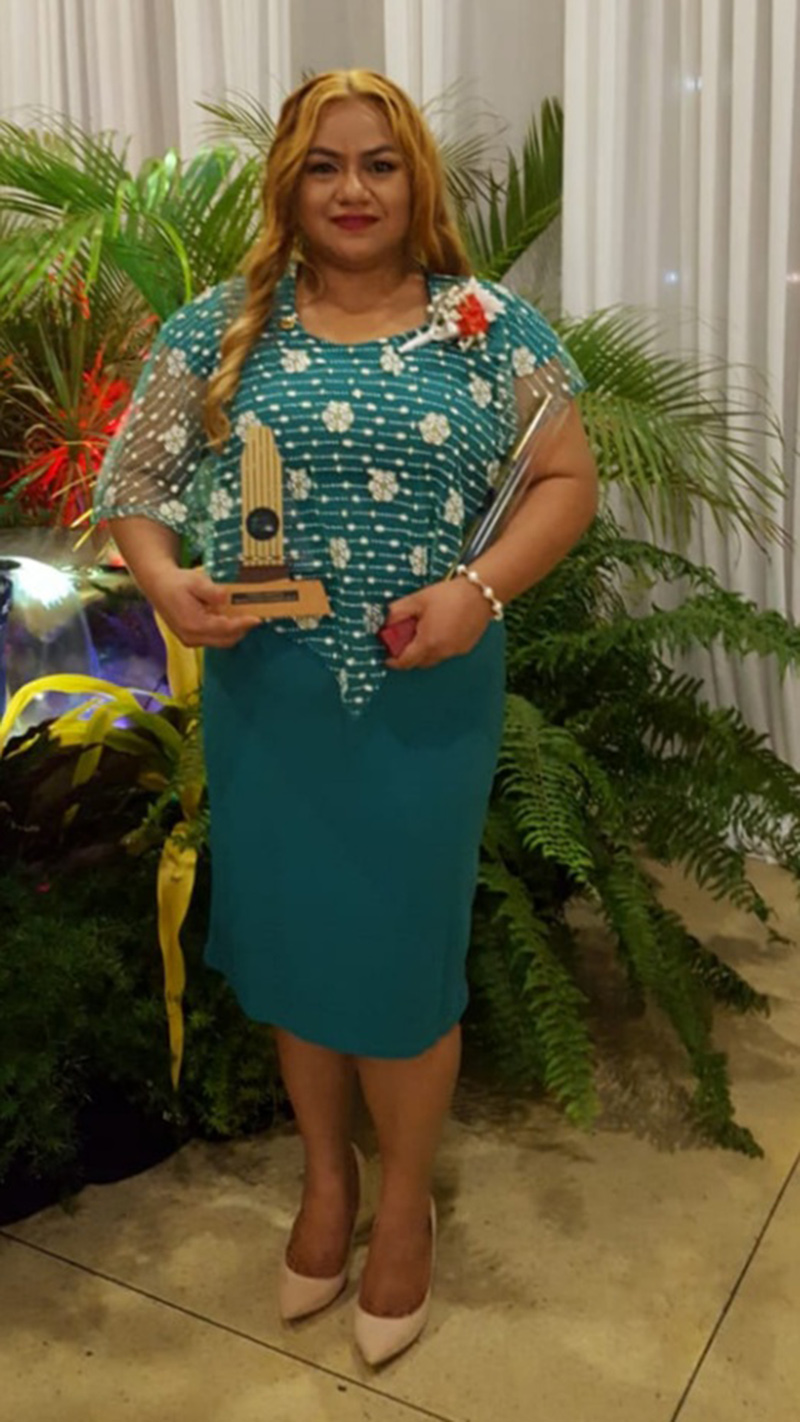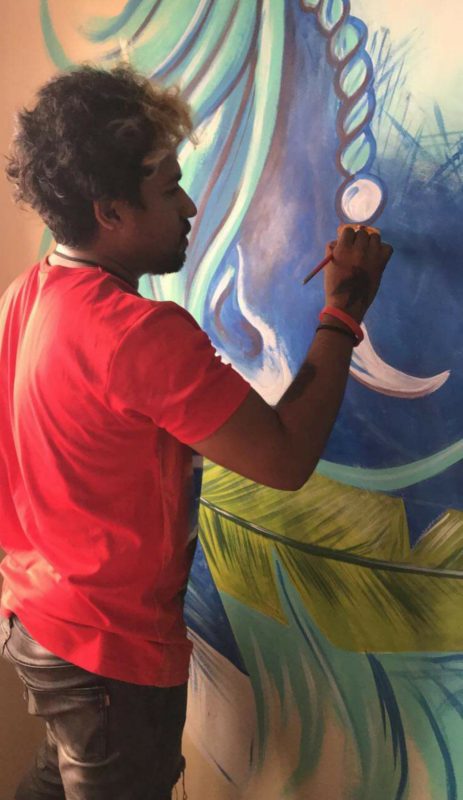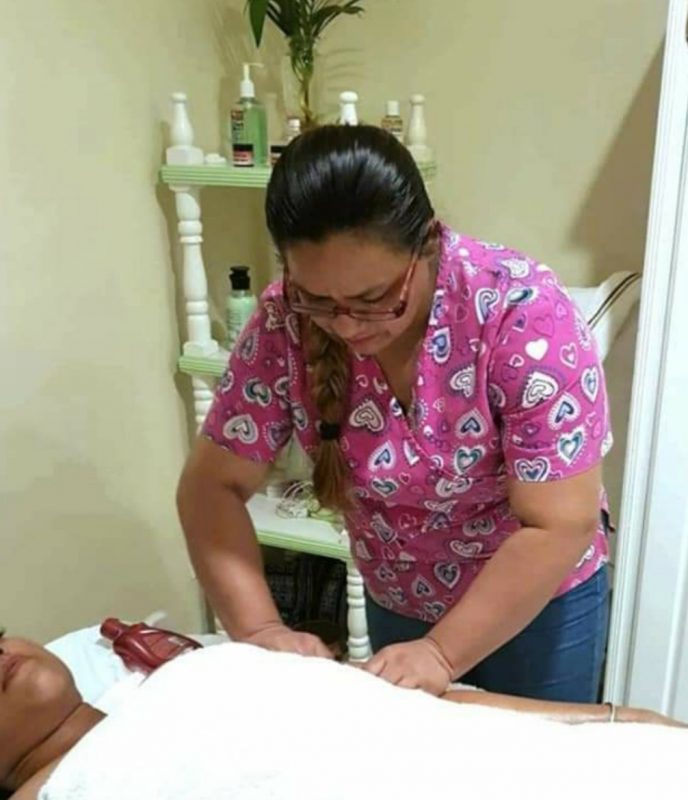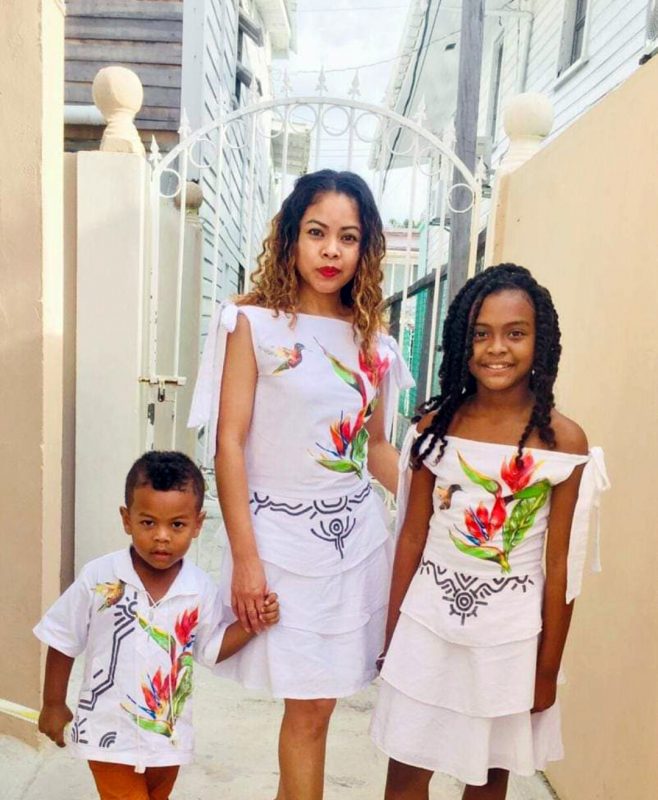Needing to return to work to take care of her two children after her marriage failed, Vanda Allicock chose the worlds of fashion and massage therapy to not only earn an income and maintain a sense of independence but also to highlight the cultural traditions and beauty in nature so integral to the Indigenous way of life.
“I wanted to do something. I didn’t want to leave the children alone at home. I didn’t know what I was going to do. How am I going to get money? Where am I supposed to go? How am I going to mind these children? These things were in my head,” Allicock said.
In an interview, Allicock, who was born in the village of Surama in North Rupununi, told Stabroek Weekend she knew she did not want a nine-to-five job because she wanted to be “there” for her children. She had worked as a teacher at Fairview Primary for a year and a half, just after leaving high school, and then as a research assistant at Iwokrama International Centre for Rainforest Conservation and Development in Region Eight- Potaro/Siparuni.
The mother of two children, she left Iwokrama after she got her first child and moved back to Georgetown. When her daughter was eight years old, she wanted to get back into the world of work and into entrepreneurship but she needed assistance.
She had started doing batik work with an aunt even before her spouse left the home and she liked the novelty and artistry of handicraft.
She did some serious thinking and decided to enlist the help of her nephew, Nigel Butler, who was “very good” at art, to help her carry out what she was thinking of doing. She shared her idea with him about designing and painting things that represent the Indigenous culture and things relative to nature on shirts and asked him if he will paint them after which she will market the finish product. Butler agreed. She was encouraged and assisted by administrator Anna Iles, who also provided some shirts and paint.
“My father was our first customer.” She said. Her father, former vice president and minister of the then Ministry of Indigenous Peoples Affairs (MOIPA), Sydney Allicock, bought all the shirts and gave them to his friends and colleagues as gifts.
They started in 2012 and when Butler was admitted to the Burrowes School of Arts in the city in 2015 and could not assist Allicock with painting, they both took a brief break from the venture. “I am not the artist and I did not try to do Nigel’s work after he left for school,” she said.
In 2016, Allicock met designer, entrepreneur and mentor Sonia Noel and with her encouragement they met with then junior minister in MOIPA Valerie Garrido-Lowe about showcasing an Indigenous fashion line at Guyana Fashion Week.
Vanda Designs
“Coming out of that meeting, I did a clothing line under the brand, Vanda Designs, for the Guyana Week Fashion Show. It was my first line of clothing and my first fashion show. I learnt a lot. The hand painting was led by Nigel who came back on board.”
After the fashion week, Allicock said, they started getting orders. Butler is now a graduate of the art school.
“Indigenous fashion is not something you go and get on the market. I try to make modern clothing but with an indigenous touch to it. We came up with the idea of modern clothing which we wear every day. A lot of people don’t want the beads and the seeds because you can’t wash them without destroying them. So we replicated the beads in painting which you can wash after wearing.”
She said they paint everything that they lived and know about in their village and the Indigenous way of life. “Things that I grow up seeing or knowing in my environment. From the mountains of the Pakaraimas range, including Surama Mountain and Pond Mountain, all the way from the Brazilian border surrounding our village. From the rainforest, trees to leaves to twigs, beads, seeds, flowers, birds, animals, whatever comes from our culture. I do the petroglyphs. We recreate designs based on natural forms and in petroglyphs.”
She added, “We take the artistry from our craft, like baskets, warashis and matapees, and we do our own twist from the kinds of weaving found on those crafts to our designs. Some of these we have showcased in our line designs.”
Her father, a fan of her work, suggested they sew their own clothes and make it their own brand instead of buying standard ready-made garments. They considered the suggestion and after the Fashion Week they started looking for seamstresses and so they began sewing their own garments.
“That was challenging. Yes, I have learnt to sew. I started a new class to familiarize myself with sewing. I know the intricacies of sewing, stitches, knowing materials, different types of cuts and folds. That was another learning experience,” Allicock said.
This time around, to assist Butler and to meet demands, Allicock brought on the team of Vanda’s Designs, her cousin Bevan Allicock, who is also a graduate of Burrowes School of Art.
Allicock has not been able to fully exhibit her work at the Amerindian Heritage Village because of the demand for her work in the run up to Amerindian Heritage Month of activities. While Butler and Bevan Allicock work for Vanda’s Designs, she said, there is only so much work they could put in because they too have their own work as well.
Asked about accessories to match her clothing, Allicock said she collaborates with a friend, Natasha David, who makes and sells Indigenous jewellery. “So if someone is looking for accessories, I recommend her. We collaborate and I think in future we can make a good team as well. I don’t want to take away her market. So while I am developing my brand she is developing her brand at the same time.”
Early childhood
Speaking of her childhood, Allicock said growing up in Surama, a Macushi village of about 350 people, was happy and carefree and without stress. “However, we had chores like lighting the fireside, washing wares, sweeping the yard, fetching firewood, fetching water and watering plants in the yard before going to school. We always had a farm and anything you think about planting we had.” However, these chores were shared among her siblings. Her mom and an older sister did the cooking.
She was the second to last of ten siblings, three of whom are now deceased.
Allicock attended Surama Primary School and after writing the then Secondary Schools Entrance Examinations, she was offered a scholarship to School of the Nations.
Moving from Surama to the city was an eye opening experience for her. “It was totally different from the Rupununi, where if you had doors on the house you slept with them open. In the city, you have to stay indoors with grilled doors and windows and even in the yard there is limited space. The food is different, mainly rice and some kind of stew. At home in Surama, it was basically farine and whatever meat or fish we had. We got fruits from the farm. Anything you think about planting we had. You go on the tree and pick how much fruits you want and eat. In town you have to go to the market to buy a few. At home I walked to school. In Georgetown I went with a car.”
Schooling was challenging, she said, recalling moving from a multi-grade teaching classroom to a setting where teachers were assigned to teach one subject sometimes in different classrooms. “It was overwhelming at times but a lot of people helped me to adjust. It was a learning experience.”
After leaving high school she taught at Fairview Primary School, where she had to live on her own for the first time. From Fairview she was recruited to work at Iwokrama as an assistant researcher. This new job took her to different places to monitor wildlife and wetland areas throughout the Rupununi and to look at how important the wetlands are to human life, and flora and fauna.
“Even though we live in it, we still do not know much about it and how it sustains life,” she said, Iwokrama brought her closer to nature and she learnt more about Indigenous traditions, beliefs, traditional medicine, history and the need to preserve the environment.
Massage therapist
Massaging was an art that Allicock liked as a young girl and she wanted to do it to help one of her brothers, who was paraplegic. He was paralysed from the waist down and he died about five years ago.
“Growing up and looking after him, I was interested in natural medicine. For a while I could not find a course in massage therapy that was affordable to me. Eventually I completed a course on a payment plan which I paid off before the course finished. It was one of my dreams. Unfortunately, I never got to do massage therapy before my brother died and I always wanted to do it to help him.”
She does mostly home visits and with special clients. “I use natural oils including crab oil, coconut oil, and I put a natural gum which is used by our people mainly for pain, in my oils. Some people don’t like the scent of crab oil so again I use some natural sweet scents including peppermint or scented massage oil. I mix my own oils. I cater to anyone. If I cannot help I recommend a doctor.”
She has helped to massage people who cannot afford to pay for her service. “I am not stingy with my services. I look forward to doing massage in pregnancy and natural healing using heat. I know there are Indigenous people who still do that to assist in an easier delivery and as part of the healing process.”
Somethings, sometimes may look silly, she said. “When you look at it, you now understand why they did certain things. Like when you give birth the old people would scatter coals from the fire side under the hammock. That heat helps to bring the remains of childbirth down. That is a form of healing. For back pains they would scatter the coals under the hammock and that heat would help with back pain. Similarly, when you go to for therapy in the modern setting, they would put heat on your back with a hot towel. It’s just a towel in hot water. Just a different method.”
She expressed hope that when she can travel outside of the pandemic and meet some of the elders with the knowledge she can learn from them. “I just wanted to do these things to make me a better person.”
Allicock added that she was timid and afraid to talk and share her experience. “If you had called me before, say a year ago, I would not have spoken to you, but I am improving. Indigenous culture is a big thing for me and maybe down the road, I can even write a book of traditional Indigenous stories,” she said.









